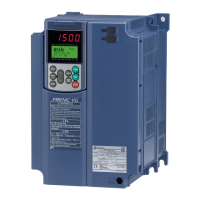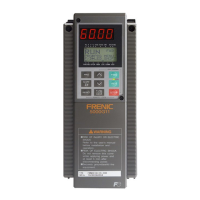6-7
Chap. 6 TROUBLESHOOTING
Possible Causes What to Check and Suggested Measures
(4) The wiring length between the
inverter and the motor is too
long.
Check whether auto-torque boost, auto-energy saving operation, or dynamic torque
vector control is enabled.
Î Perform auto-tuning of the inverter for every motor to be used.
Î Disable the automatic control systems by setting F37* to "1" (Constant torque
load) and F42* to "0" (V/f control with slip compensation active), then check
that the motor vibration stops.
Î Make the output wires as short as possible.
Once disable all the automatic control systems such as auto torque boost, auto
energy saving operation, overload prevention control, current limiter, torque limiter,
automatic deceleration (anti-regenerative control), auto search for idling motor
speed, slip compensation, dynamic torque vector control, droop control, overload
stop function, speed control, online tuning, notch filter, observer, and then check
that the motor vibration comes to a stop.
Î Disable the functions causing the vibration.
Î Readjust the output current fluctuation damping gain (H80*).
Î Readjust the speed control systems. (d01* through d06*)
(5) The machinery is hunting due
to vibration caused by low
rigidity of the load. Or the
current is irregularly oscillating
due to special motor
parameters.
Check that the motor vibration is suppressed if you decrease the level of F26 (Motor
sound (Carrier frequency)) or set F27 (Motor sound (Tone)) to "0."
Î Decrease the carrier frequency (F26) or set the tone to "0" (F27 = 0).
[ 5 ] Grating sound is heard from the motor or the motor sound fluctuates.
Possible Causes What to Check and Suggested Measures
(1) The specified carrier frequency
is too low.
Check the data of function codes F26 (Motor sound (Carrier frequency)) and F27
(Motor sound (Tone)).
Î Increase the carrier frequency (F26).
Î Change the setting of F27 to appropriate value.
(2) The surrounding temperature
of the inverter was too high
(when automatic lowering of
the carrier frequency was
enabled by H98).
Measure the temperature inside the panel where the inverter is mounted.
Î If it is over 40°C, lower it by improving the ventilation.
Î Lower the temperature of the inverter by reducing the load. (For fans or pumps,
decrease the frequency limiter value (F15).)
Note: If you disable H98, an
0h1
,
0h3
, or
0lu
alarm may occur.
(3) Resonance with the load. Check the machinery mounting accuracy or check whether there is resonance with
the mounting base.
Î Disconnect the motor from the machinery and run it alone, then find where the
resonance comes from. Upon locating the cause, improve the characteristics of
the source of the resonance.
Î Adjust the settings of C01 (Jump frequency 1) to C04 (Jump frequency
(Hysteresis width)) so as to avoid continuous running in the frequency range
causing resonance.
Î Enable the speed control (notch filter) (d07*, d08*) and the observer (d18 to
d20) to suppress vibration. (Depending on the characteristics of the load, this
may take no effect.)
[ 6 ] The motor does not accelerate or decelerate within the specified time.
Possible Causes What to Check and Suggested Measures
(1) The inverter runs the motor
with S-curve or curvilinear
pattern.
Check the data of function code H07 (Acceleration/deceleration pattern).
Î Select the linear pattern (H07 = 0).
Î Shorten the acceleration/deceleration time (F07, F08, E10 through E15).
(2) The current limiting operation
prevented the output frequency
from increasing (during
acceleration).
Make sure that F43 (Current limiter (Mode selection)) is set to "2: Enable during
acceleration and at constant speed," then check that the setting of F44 (Current
limiter (Level)) is reasonable.
Î Readjust the setting of F44 to appropriate value, or disable the function of
current limiter with F43.
Î Increase the acceleration/deceleration time (F07, F08, E10 through E15).
(3) The automatic deceleration
(Anti-regenerative control) is
enabled during deceleration.
Check the data of function code H69 (Automatic deceleration (Mode selection)).
Î Increase the deceleration time (F08, E11, E13, and E15).
(4) Overload. Measure the output current.
Î Reduce the load (For fans or pumps, decrease the frequency limiter value
(F15).) (In winter, the load tends to increase.)

